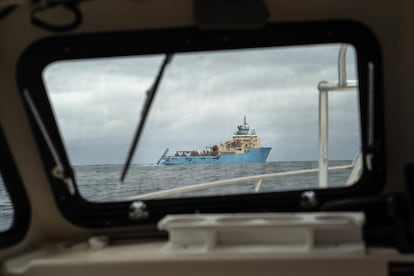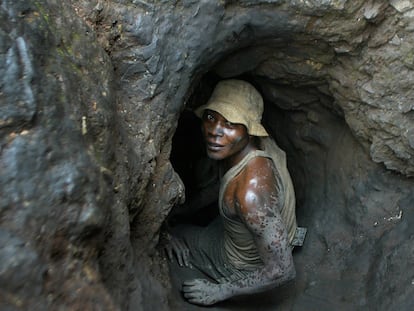A legal battle 20,000 feet under the sea: the treasures hidden in the abyss
The oceans store minerals that are essential for the green transition but their exploitation comes at a high environmental cost


For thousands of years, human beings respected the darkness and silence that lies up to 21,325 feet at the bottom of the ocean. However, technology has made possible what was once science fiction, allowing humans to now extract essential minerals for the green transition — minerals for wind turbines, mobile phones and electric batteries — from the depths. The possible benefits are colossal… as is the damage to the environment.
This contentious present begins in the past. In 1994, the United Nations created the International Seabed Authority (ISA) to ensure that minerals extracted from international waters would benefit humanity. Its decisions are made by a rotating council of 36 members, representing the 167 countries that have ratified the Law of the Sea. The United States participates as an observer. This body of international law requires that any company that wants to explore deep sea mining must pay the ISA around $500,000 for a license and be supported by a member country that will ensure that the firm complies with environmental regulations. Since 2001, government agencies and private companies have extracted minerals from more than 500,000 square miles in the Indian, Pacific and Atlantic oceans. But recent investigations by The Los Angeles Times and The New York Times reveal the close relationship that the ISA secretariat maintains with certain mining firms, along with the pressure exerted on some weaker nations to gain support for deep sea mining operations.
The regulation is so outdated that mining companies have found a big loophole. In June of 2021, Nauru — a tiny Pacific island — warned that the UN treaty requires the ISA to complete negotiations in two years. Otherwise, come July, they have the right to exploit their water’s minerals: something that has previously been prohibited.
The Republic of Nauru has endorsed the operations of The Metals Company (TMC), a Canadian start-up. “While the regulator will be accepting applications shortly, this doesn’t mean that our subsidiary, Norin, will begin to operate,” TMC notes in a statement. “Together with Nauru, we have committed to submit a commercial contract application only after completing a thorough and scientific environmental and social impact assessment of the highest quality.” However, if they obtain the license, they could start extracting minerals by the end of next year, or the start of 2025. The New York Times estimates that, in two decades, they can rake in revenues of $30 billion from 240 million tons of material.
The situation is muddied by too much pressure, too much money and too many geopolitical interests. TMC has three exploratory contracts but China has five, the largest amount around the island. Beijing doesn’t want to lose its lead in amassing critical minerals. Its diplomats argue that environmental concerns should never underestimate the economic benefits of mining. This opinion is shared by Belgium, France, the United Kingdom, Germany, India, South Korea, Russia and Singapore, who have around 30 exploration agreements approved by the ISA. “We need those minerals. But we must make sure that we don’t harm nature,” says Michael Widmer, a metals strategist at Bank of America.
In a surprise move, American defense giant Lockheed Martin recently sold its deep sea mining subsidiary — UK Seabed Resources — to the Norwegian firm Loke Marine Minerals. In turn, the shipping company Maersk is leaving the industry. Companies such as Samsung, BMW, Google, Renault, Volvo and Philips are asking for a moratorium to fully understand the environmental consequences of bolstering deep sea mining. This request is supported, above all, by the governments of Chile, Costa Rica, Ecuador, New Zealand and Spain. France, meanwhile, is demanding an absolute ban on deep sea mining.
“Extractive activity is safe and our technology guarantees minimal environmental impact,” emphasizes Walter Sognnes, the CEO of Loke Marine Minerals, in a defense of his firm. British lawyer Michael Lodge, the ISA’s secretary general, has warned that a moratorium is “against international law.”
Where the light never reaches
Down below — where the light never reaches — these miners are after polymetallic nodules. The mineral clumps are covered with sand, at a depth of between 13,000 and 21,325 feet. The largest reserves run between Mexico and Hawaii; they contain manganese, copper, cobalt, nickel and traces of rare earth elements.
“Harvesting the nodules requires much less energy than the traditional method [of mainland mining]. Since the concentration of metals is much higher, refinement is also easier,” says Seaver Wang, co-director of the Energy and Climate Program at the Breakthrough Institute in California. Wang has no doubt that, if one company succeeds in such an endeavor, others will follow. In July, it’s unlikely that the regulations will be approved. Without them, “no company will exploit minerals, although tons have already been removed durings tests,” says Sian Owen, director of the Deep Sea Conservation Coalition (DSCC). For instance, the Canadian firm collected 4,500 tons in tests from the waters around Nauru in 2022 alone. The New York Times reveals that the company has designed an underwater vehicle with the capacity to “lift” 3,200 tons of polymetallic nodules from the floor of the Pacific Ocean.
The Law of the Sea also establishes that states have the right to explore and exploit their natural resources (wind or tidal energy) up to 200 nautical miles from their coasts. This includes minerals. Norway has set aside an area of 127,000 square miles (almost the size of Germany) to study the feasibility of deep sea mining. The public agency responsible for regulating resources — the Norwegian Petroleum Directorate (NPD) — has discovered significant amounts of offshore cobalt, copper, manganese, nickel and rare earth elements.
Sign up for our weekly newsletter to get more English-language news coverage from EL PAÍS USA Edition
Tu suscripción se está usando en otro dispositivo
¿Quieres añadir otro usuario a tu suscripción?
Si continúas leyendo en este dispositivo, no se podrá leer en el otro.
FlechaTu suscripción se está usando en otro dispositivo y solo puedes acceder a EL PAÍS desde un dispositivo a la vez.
Si quieres compartir tu cuenta, cambia tu suscripción a la modalidad Premium, así podrás añadir otro usuario. Cada uno accederá con su propia cuenta de email, lo que os permitirá personalizar vuestra experiencia en EL PAÍS.
¿Tienes una suscripción de empresa? Accede aquí para contratar más cuentas.
En el caso de no saber quién está usando tu cuenta, te recomendamos cambiar tu contraseña aquí.
Si decides continuar compartiendo tu cuenta, este mensaje se mostrará en tu dispositivo y en el de la otra persona que está usando tu cuenta de forma indefinida, afectando a tu experiencia de lectura. Puedes consultar aquí los términos y condiciones de la suscripción digital.
More information
Archived In
Últimas noticias
There is as much life left to discover on planet Earth as that which is already known
Dozens presumed dead, around 100 injured in fire at Swiss Alps bar during New Year’s celebration
Is porn for women different from conventional porn? We spoke to those who make it
Cartagena de Indias is sinking: What can the city do to mitigate it?
Most viewed
- Sinaloa Cartel war is taking its toll on Los Chapitos
- Reinhard Genzel, Nobel laureate in physics: ‘One-minute videos will never give you the truth’
- David King, chemist: ‘There are scientists studying how to cool the planet; nobody should stop these experiments from happening’
- Oona Chaplin: ‘I told James Cameron that I was living in a treehouse and starting a permaculture project with a friend’
- The Interoceanic Train, the Mexican alternative to the Panama Canal










































